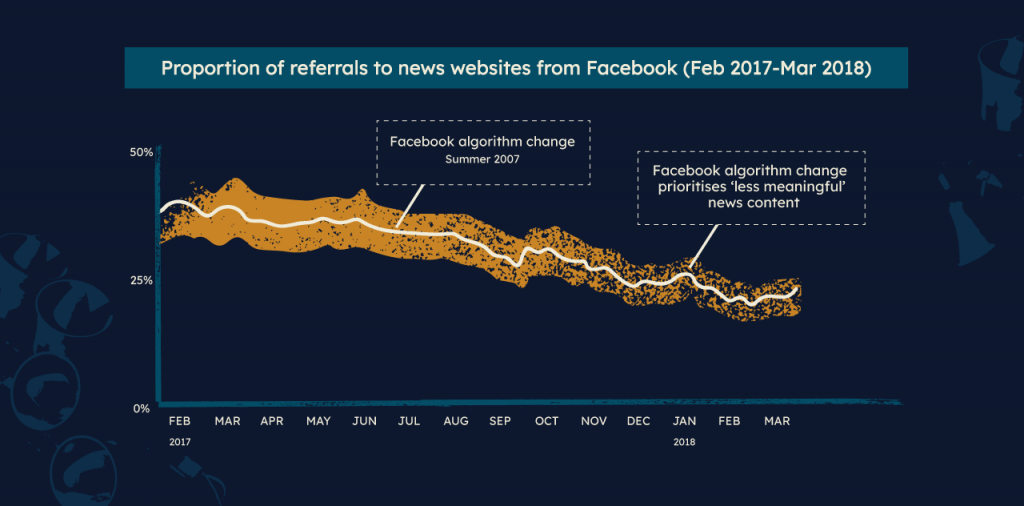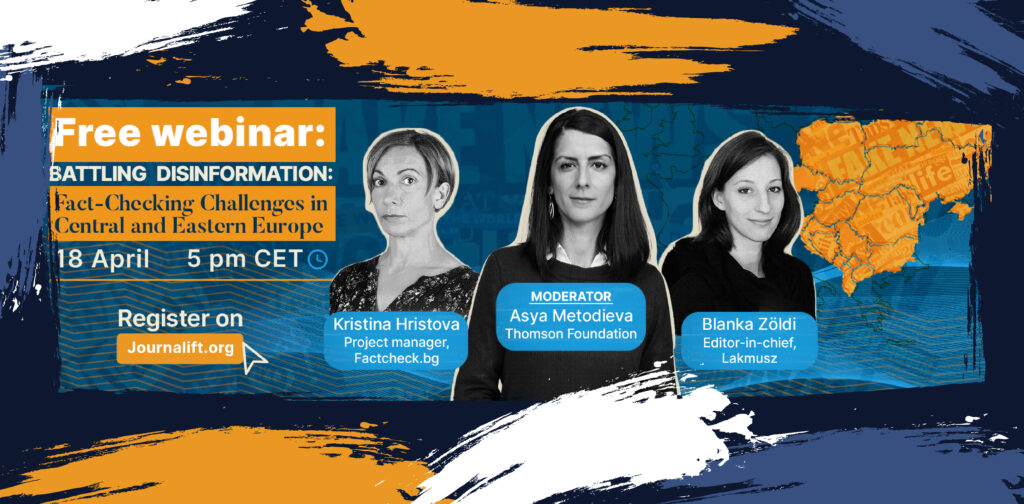As a popular saying among the digital media publishers goes, “if your business model is based on Facebook, you don’t have a business model”. Yet, doing media business today without Facebook (and other social media) is virtually impossible. This holds true not only for small media and start-ups, but also for large broadcast organizations with millions of viewers whose primary revenue still comes from traditional advertising. The reason is quite simple: fewer and fewer users access media via the channels owned by the media publishers.
According to the Reuters Institute for the Study of Journalism 2020 Digital News Report,
“Across all countries, just over a quarter (28%) prefer to start their news journeys with a website or app, followed by social media (26%) – up two percentage points on last year. Once again, though, we see very different patterns with 18–24s, the so-called Generation Z. This group has a much weaker direct connection with news brands (16%) and is almost twice as likely to prefer to access news via social media (38%).”
In dollar terms, this means that the tiny part of digital advertising budgets that still gets invested directly in media publishers is diminishing by the day. And this is a trend that will only worsen for the publishers, for further benefit of the social media giants.
So, the question media publishers have been asking themselves across the world is quite similar.
How do you survive the competition with the social media super giants, who don’t spend anything on content themselves, use your content for free, and lure away your advertisers? And is it at all possible to make money using social media?

Surviving the Competition with Social Media Super Giants
The reality is that social media wasn’t made for the media (or anyone else) to make money, that’s reserved for Mr Zuckerberg & Co. Facebook et al. don’t have to spend money on producing content – they use the content media publishers voluntarily give them for free by posting; and thanks to their vast network of users are in a position to undersell the media by offering lower prices and better targeted reach, taking away advertisers from the publishers. Social media make no secret of this lucrative business model. In Mr Zuckerberg’s own words:
“…small businesses—which create most of the jobs and economic growth around the world—get access to tools that help them thrive. There are more than 90 million small businesses on Facebook, and they make up a large part of our business.”
These are the same small businesses that local media have always depended on. There are two potential ways around this:
- get paid by social media
- use smart social media tactics to support your marketing, grow the audience on your own platforms and accelerate non-social media revenue.
However, it is important to keep in mind that these two should not necessarily be seen as alternatives.

How to Make Social Media Pay for Your Content
Getting paid by social media may seem a promising prospect, and is starting to happen in some of the larger markets in the world where media publishers’ associations are cutting deals with Google and Facebook to get paid for the content they post.
All eyes are now (March 2021) on Australia, the current frontier of the proxy war between publishers and tech giants (more on the story here, see also Google and Facebook’s positions). Similar legislative measures are being introduced or prepared for introduction in the EU. Controversial and partial arrangements are being made in France, Germany and are in negotiations elsewhere. Yet, this process will take a long time to reach places like the Western Balkans; and will never fully offset the loss of digital advertising.
Step one to get the ball rolling on anything like this is have the majority of media outlets in the countries concerned unite and get their governments’ firm support to introduce legislative measures, aligned with the EU actions.
This may prove to be a very long shot, given the fractioned media markets and the low bargaining power of smaller countries vs the tech giants. However, a decisive move by the EU, and anti-trust action in the US, might change this picture in the long run. Sadly, the EU isn’t known for rapid and decisive moves and the process, while certain, may take years to accomplish and even more years to spread beyond the EU Member States. In the short term, it is still too early to start projecting direct revenues for media in the Western Balkans from reimbursement for content from the social media giants.
Getting smart with your social media tactics
Media organisations proudly show off high numbers of social media followers and often use paid promotion to get them . While numerous likes and shares are great for the media’s self-esteem, these numbers will not automatically bring customers to your estate (TV screens, radio waves, websites, printed papers). Used without caution, this type of behaviour may actually destroy you in the long run.
Here’s what to be careful about:
1. Reputational damage
Users trust social media significantly less than professional media. The rationale behind this is not hard to understand: social media is full of amateur, corporate, political and fake news content which is formatted and presented exactly in the same way as the content that originates from a professional and respected media organization.
Unless you have a strong and established brand, immediately recognizable by the user, publishing on social media side by side with all the other content already circulating, there may diminish the relative value users give to your content. Media publishers would be wise to take their brand development and brand awareness very seriously and avoid the “clickbait” temptation: publications that may attract a lot of traffic, but will hurt your reputation as a distinguishable and reliable provider of information and news people can trust.
Graph by the Reuters Institute for the Study of Journalism 2020 Digital News Report clearly shows the significant gap in trust, especially on hard issues of common concern such as the Covid crisis.

Moreover, Facebook has recently removed the option to disable comments under posts on pages and in groups, which means that in order to avoid potential reputational damage by trolls, haters etc., publishers need to spend valuable human resources on timely “moderation” of their pages, which brings us to the next issue.
2. Depleting resources and competing with yourself
Many media organizations aim to put on social media channels as much content as possible, and often create unique content or spend time adapting existing content for these platforms.
While regular posting and using platform-specific content is important, the key message here should be that “less is more”.
You don’t want to replace your media screen/channel/website etc. with a Facebook timeline or newsfeed. Likewise, you don’t want to use a lot of your professional staff’s time on feeding with content a multi-billion-dollar platform, rather than on the creation of value for your audience. With the limited resources, any newsroom these days has, who do you hire first: a content creator who will develop unique professional journalism for your media, or a (much cheaper and easily replaceable) junior social media “manager”?
Ideally, your social media should serve primarily for marketing, and to bring visitors to your exclusive content. Having more unique quality content to offer to your target audience matters much more than having a big number of random visitors scrolling down through your posts on social media, only to register the “three-second view”.
3. Unreliability
No matter how good your social media skills are, the platform may decide to change its algorithm without notice, as Facebook did in 2017 and 2019, and again in 2019-2020 (last time in favour of news content, as a part of its Covid response), or to take your page down altogether, for political bargaining reasons (the case of Australia) or for “policy violation” reasons (remember the infamous blocking of an account by Facebook of a Norwegian writer for publishing a Pulitzer prize-winning photograph).

Why would such things happen? Because a bot somewhere could deem a picture or some text in line with its instructions. As a result, your account and online reputation will take days and weeks to recover. Relying too much on social media for traffic is risky and makes your media even more vulnerable to policies over which you have no say.
4. Price dumping and opaque reporting
Social media can afford to be much cheaper than almost anyone else. They don’t have to spend on producing content, and they can manipulate both supply and demand - what is seen and what is sold on their platforms.
Social media platforms can also present data in a way that doesn’t make much sense to the average user (for more details, follow the link below) Anyone who tries comparing data from social media campaigns with actual online traffic to a website will discover discrepancies.
These discrepancies are possible to explain with most likely deliberate usage of different metrics, but in reality, are not of much help to advertisers who want to see the actual value of their investment.
However, not being on social media is not an option, as it is usually the first choice of your audience. And not using its reach to your target audience would be a huge missed opportunity. Making social media work for you, however, takes advanced skills going far beyond the regular posting of content and paying for reach.
How Can You Make the Most Out of Social Media?
































